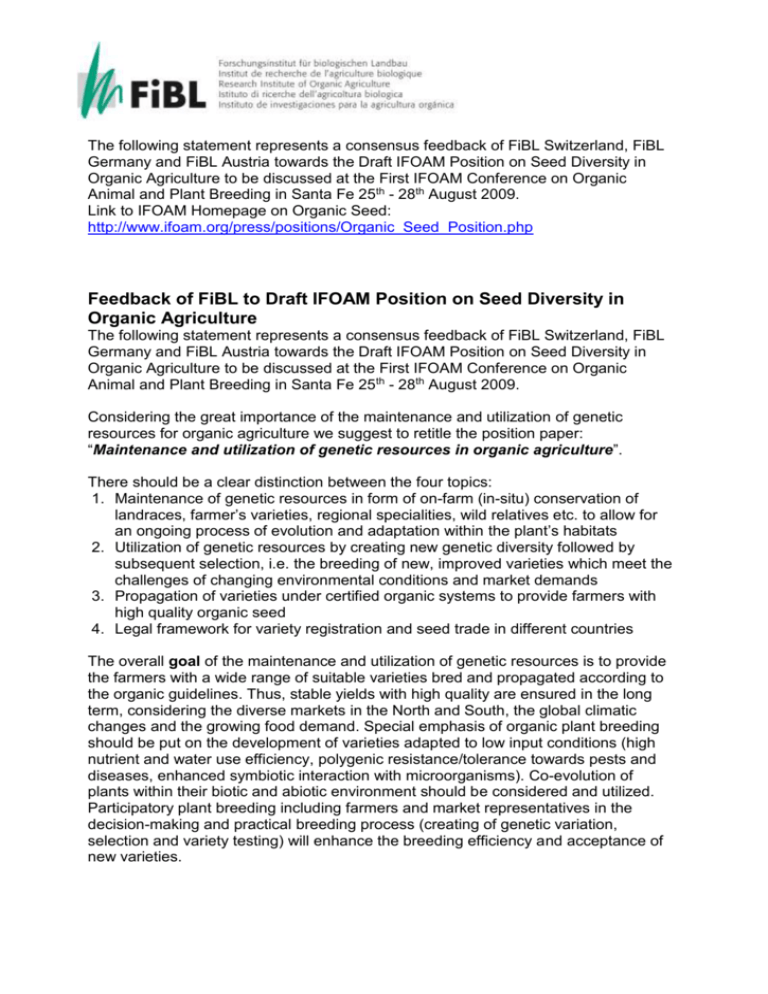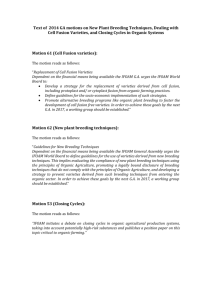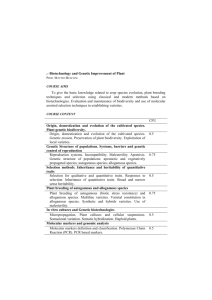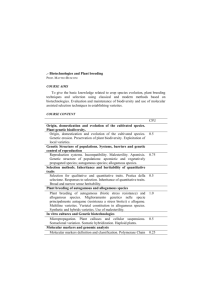Feedback of FiBL to Draft IFOAM Positon on Seed Diversity in
advertisement

The following statement represents a consensus feedback of FiBL Switzerland, FiBL Germany and FiBL Austria towards the Draft IFOAM Position on Seed Diversity in Organic Agriculture to be discussed at the First IFOAM Conference on Organic Animal and Plant Breeding in Santa Fe 25th - 28th August 2009. Link to IFOAM Homepage on Organic Seed: http://www.ifoam.org/press/positions/Organic_Seed_Position.php Feedback of FiBL to Draft IFOAM Position on Seed Diversity in Organic Agriculture The following statement represents a consensus feedback of FiBL Switzerland, FiBL Germany and FiBL Austria towards the Draft IFOAM Position on Seed Diversity in Organic Agriculture to be discussed at the First IFOAM Conference on Organic Animal and Plant Breeding in Santa Fe 25th - 28th August 2009. Considering the great importance of the maintenance and utilization of genetic resources for organic agriculture we suggest to retitle the position paper: “Maintenance and utilization of genetic resources in organic agriculture”. There should be a clear distinction between the four topics: 1. Maintenance of genetic resources in form of on-farm (in-situ) conservation of landraces, farmer’s varieties, regional specialities, wild relatives etc. to allow for an ongoing process of evolution and adaptation within the plant’s habitats 2. Utilization of genetic resources by creating new genetic diversity followed by subsequent selection, i.e. the breeding of new, improved varieties which meet the challenges of changing environmental conditions and market demands 3. Propagation of varieties under certified organic systems to provide farmers with high quality organic seed 4. Legal framework for variety registration and seed trade in different countries The overall goal of the maintenance and utilization of genetic resources is to provide the farmers with a wide range of suitable varieties bred and propagated according to the organic guidelines. Thus, stable yields with high quality are ensured in the long term, considering the diverse markets in the North and South, the global climatic changes and the growing food demand. Special emphasis of organic plant breeding should be put on the development of varieties adapted to low input conditions (high nutrient and water use efficiency, polygenic resistance/tolerance towards pests and diseases, enhanced symbiotic interaction with microorganisms). Co-evolution of plants within their biotic and abiotic environment should be considered and utilized. Participatory plant breeding including farmers and market representatives in the decision-making and practical breeding process (creating of genetic variation, selection and variety testing) will enhance the breeding efficiency and acceptance of new varieties. Presently, the number of suitable varieties for organic agriculture is very limited and the genetic are not fully exploited as breeding for organic agriculture still is a small and very diverse market. Even the propagation of varieties under certified organic production cannot meet the present quantitative and qualitative demand of the market, for certain crops the seed health is still a very serious issue that needs to be tackled quickly to ensure a closed organic production system. 1. Maintenance of genetic resources in form of on farm (in-situ) conservation of landraces, farmer’s varieties, regional specialities, wild relatives etc. to allow for an ongoing process of evolution and adaptation within the plant’s habitats Genetic resources are an invaluable treasure and need to be carefully protected. In order to maintain landraces and regional varieties for present and future needs, it is important to define genetic resources and specific geographic regions for their propagation and to avoid gene erosion by gene flow from mainstream varieties. The efforts to maintain genetic resources should be refunded. 2. Utilization of genetic resources by creating new genetic diversity followed by subsequent selection, i.e. the breeding of new, improved varieties which meet the challenges of changing environmental conditions and market demands To be able to guarantee sustainable plant production meeting all kind of present and future challenges, it is essential to continue the genetic progress of new varieties which started with the settling of mankind. For the development of improved varieties suitable for organic agriculture, special emphasis must be put on the diverse organic management systems. In addition, breeding strategies and techniques which are in line with organic agriculture need to be defined. Moreover, the exclusion of genetically modified organisms needs to be established. The criteria for the evaluation of breeding strategies and techniques need to be elaborated further. A very important issue to guarantee successful breeding is the free access to genetic resources (breeder’s right), therefore patents on genes and genetic material should be ruled out in organic breeding programmes. 3. Propagation of varieties under certified organic systems to provide farmers with high quality organic seed Ideally all plant production should be based on organically bred and organically propagated varieties. As long as the number of organically bred varieties is very limited or inexistent for certain crops conventionally bred varieties should be allowed. However, the seeds of such varieties have to be propagated under certified organic systems. This is important to maintain on one hand the credibility of organic production to the customers and on the other hand to give strong incentive to the breeders to develop special varieties for the organic sector. Combined efforts are needed to enhance the number of varieties available as organic seed and to increase the quality of these seeds with respect to seed health, germination rate and vigour. 4. Legal framework for variety registration and seed trade in different countries The legal framework of variety registration, plant patenting and seed law can constrain the free access to genetic material and the exchange of varieties that do not meet the requirements of variety registration. This is especially true for farmer’s varieties, conservation varieties or old landraces.. Even, newly bred or improved varieties might not pass this bottleneck due to insufficient genetic homogeneity within the variety. Therefore, different regulations for variety and seed exchange should be aspired. Frick, August 20th 2009, Monika Messmer on behalf of Germany, and FiBL Austria Name Organization Email IFOAM Member No. FiBL.Switzerland, FiBL Monika Messmer Research Insititute for Organic Agriculture FiBL Switzerland – FiBL Germany – FiBL Austria monika.messmer@fibl.org Yes





